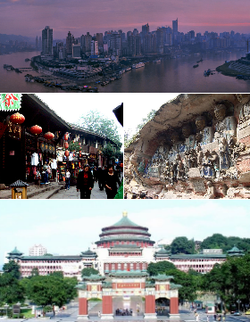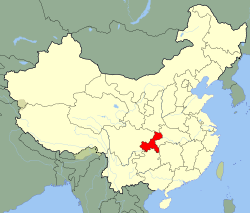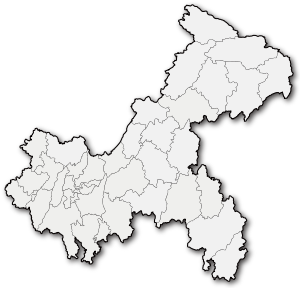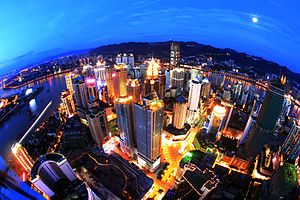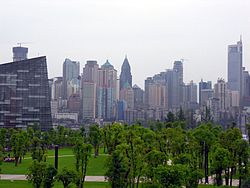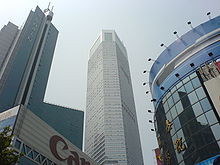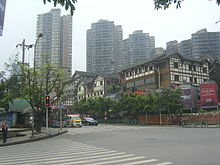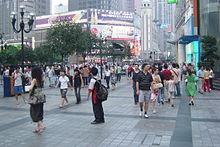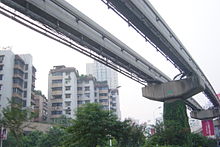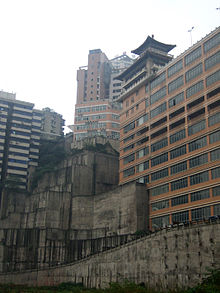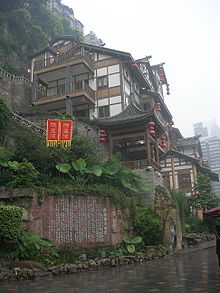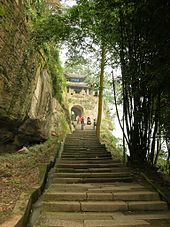- Chongqing
-
For other uses, see Chongqing (disambiguation).
Chongqing
重庆— Municipality — Municipality of Chongqing • 重庆市 From top:Yuzhong Skyline , CRT Line 2 Monorail, Chaotianmen Bridge, and Great Hall of the People Location of Chongqing Municipality within China Coordinates: 29°33′30″N 106°34′00″E / 29.55833°N 106.5666667°ECoordinates: 29°33′30″N 106°34′00″E / 29.55833°N 106.5666667°E Country People's Republic of China Settled ca. 316 BCE Divisions
- County-level
- Township-level
19 districts, 21 county
1259 towns, townships, and subdistrictsGovernment – Type Municipality – CPC Ctte Secretary Bo Xilai – Mayor Huang Qifan Area – Municipality 82,401 km2 (31,815.2 sq mi) Elevation 237 m (778 ft) Population (2010)[1] – Municipality 28,846,170 – Density 350.1/km2 (906.7/sq mi) Demonym Chongqinger Time zone China standard time (UTC+8) Postal code 4000 00 - 4099 00 Area code(s) 23 GDP 2010 - Total CNY 789.4 billion
(US$ 122.5 billion) (23rd)- Per capita CNY 22,909
(US$ 3554) (13th)HDI (2008) 0.783 (18th) — medium Licence plate prefixes 渝 A, B, C, F, G, H ISO 3166-2 CN-50 City flower Camellia City tree Ficus lacor Website (Chinese) www.cq.gov.cn
(English) english.cq.gov.cn/Chongqing Simplified Chinese 重庆 Traditional Chinese 重慶 Hanyu Pinyin Chóngqìng Sichuanese Pinyin Cong2qin4 ([tsʰoŋ˨˩tɕʰin˨˩˦]) Literal meaning double celebration or celebrate again Transcriptions Hakka - Romanization Tshùng-khin Mandarin - Hanyu Pinyin Chóngqìng - Wade–Giles Ch'ung-ch'ing - Postal Map Chungking - Sichuanese Pinyin Cong2qin4 ([tsʰoŋ˨˩tɕʰin˨˩˦]) Min - Hokkien POJ Tiōng-khèng Wu - Romanization zon上chin去 Cantonese (Yue) - Jyutping cung4hing3 Chongqing (Chinese: 重庆; Chinese Postal Map Romanization: Chungking) is a major city in Southwest China and one of the five national central cities of the People's Republic of China. Administratively, it is one of the PRC's four direct-controlled municipalities (the other three are Beijing, Shanghai and Tianjin), and the only such municipality in inland China.
The municipality was created on 14 March 1997, succeeding the sub-provincial city administration that was part of Sichuan Province. As of November 2010, the municipality had a population of 28,846,200.[1] It has jurisdiction over 19 districts, 17 counties, and four autonomous counties. With an area of 82,401 km² (31,800 mi²), it is the largest direct-controlled municipality, larger even than one province and an autonomous region.[2] It is possibly the world's largest municipality by population and one of the largest by area.
The municipal abbreviation, 渝 (Yú), was approved by the State Council on 18 April 1997. Chongqing was also a municipality of the Republic of China administration, serving as its wartime capital during the Second Sino-Japanese War (1937–1945). Its abbreviated name is derived from the old name of a part of the Jialing River that runs through Chongqing and feeds the Yangtze River.
Chongqing is one of the most notable cities for history and culture in China (历史文化名城), and serves as the economic centre of the Upstream Yangtze area. It is the major manufacturing centre and a transportation hub for Southwest China.
Contents
History
Tradition associates Chongqing with the semi-legendary State of Ba that the Ba people supposedly established during the eleventh century BCE. By 316 BCE, however, it had been overrun by the State of Qin. The Qin emperor ordered a new city to be constructed, which was called Jiang (江州) and Chu Prefecture (楚州).
Chongqing was subsequently renamed in 581 CE (Sui Dynasty) and later 1102, to Yu Prefecture (渝州) and then Gong Prefecture (恭州). It received its current name in 1189, after Prince Zhao Dun of the Southern Song Dynasty described his crowning as king and then Emperor Guangzong as a "double/repeated happy celebration" (simplified Chinese: 双重喜庆; traditional Chinese: 雙重喜慶; pinyin: shuāngchóng xǐqìng). Hence, Yu Prefecture became Chongqing subprefecture to mark the occasion.
In 1362, (Yuan Dynasty), Ming Yuzhen, a peasant rebelling leader, established the Daxia Kingdom (大夏) at Chongqing for a short time.
In 1621 (Ming Dynasty), another short-lived kingdom of Daliang[disambiguation needed
 ] (大梁) was established by She Chongming (奢崇明) with Chongqing as its capital.
] (大梁) was established by She Chongming (奢崇明) with Chongqing as its capital.Between 1627–1645, with the fall of the Ming Dynasty, Chongqing, together with the rest of Sichuan, were captured by the Revolts who overthrew the Ming Dynasty across the nation. Later during the Qing Dynasty, immigration to Chongqing and Sichuan took place with the support of Qing emperor.
Open to the world
- In 1890, the Consulate General of UK was open in Chongqing[3]
- In 1891, Chongqing became the first inland commerce port open to foreigners.
- In 1896, the French Consulate General was open in Chongqing[4]
- In 1896, the Japanese Consulate General was open in Chongqing
- In 1896, the US Consulate General was open in Chongqing
- In 1904, the German Consulate General was open in Chongqing[5]
Provisional Capital of the Republic of China
From 1929, Chongqing became a municipality of the Republic of China. During the Second Sino-Japanese War (1937–1945), it was Generalissimo Chiang Kai-shek's provisional capital. More than 50 embassies moved to Chongqing with the KMT government at that time, and by now, some of which are still well protected. At that time, the Allies set up the Chinese Anti-fascist headquarters in Chongqing, which was responsible for directing the allied army of China, Vietnam, Thailand, Burma,and Malaysia and was under the direction of Generalissimo Chiang Kai-shek and General Joseph Stilwell. The Japanese Air Force bombed it heavily. Due to its mountainous environment, many people were saved from the bombing. And because of the brave people, their contribution and sacrifice during WWII, Chongqing is also called a City of Heroes. Many factories and universities were moved from eastern China to Chongqing during WWII, transforming this city from inland port to a heavily industrialized city. In late November 1949 the Nationalist KMT government fled the city.
- A letter from Franklin D. Roosevelt to Chongqing in 1945:
In the name of the people of the United States of America. I present this scroll to the city of Chungking as a symbol of our admiration for its brave men, women and children. Under blasts of terror from the air, even in the days before the world at large had known this horror. Chungking and its people held our firm and unconquered. They proved gloriously that terrorism cannot destroy the spirit of a people determined to be free. Their fidelity to the cause of freedom will inspire the hearts of all future generations.
In 1949, when the Peoples' Republic of China was established, Chongqing was still a municipality
In 1954, the municipality was demoted to a sub-provincial city within Sichuan Province of the People's Republic of China.
Became a Municipality again
On 14 March 1997, the Eighth National People's Congress decided to merge the city with the neighbouring Fuling, Wanxian, and Qianjiang prefecture-level districts that it had governed on behalf of the province since September 1996. The resulting single division was the Chongqing Municipality, containing 30,020,000 people in forty-three former counties (without intermediate political levels). The municipality became the spearhead of China's effort to develop its western regions and to coordinate the resettlement of residents from the reservoir areas of the Three Gorges Dam project. Its first official ceremony took place on 18 June 1997.
On 8 February 2010, Chongqing became one of the five National Central/Core cities, the other four are Beijing, Shanghai, Guangzhou and Tianjin.
On 18 June 2010, Liangjiang New Area was established in Chongqing, which is one of the 3 National New Areas, the formmer 2 are Pudong new area in Shanghai and Binhai new area in Tianjin.
Geography
All climatic data listed below comes from the central parts of the city.
- Geographic coordinates
- Latitude 28° 10' to 32° 13' N, Longitude 105° 17' to 110° 11' E.
Annual average : 18.2 °C (64.8 °F) [6] January average : 7.8 °C (46.0 °F) [6] August average : 28.5 °C (83.3 °F) [6] Historical Temperature range : −3.0 to 44.0 °C (27 to 111 °F) [7]
- Total annual hours of sunshine
- 1055
- Annual precipitation
- ~ 1,140 millimetres (45 in)
- Neighbouring provinces
- Hubei (east), Hunan (southeast), Guizhou (south), Sichuan (west), Shaanxi (north)
Located at the northern end of the Yunnan-Guizhou Plateau and the eastern limits of the Sichuan Basin, Chongqing is intersected by the Jialing River and the upper reaches of the Yangtze. It contains the Daba Mountains in the north, the Wu Mountains in the east, the Wuling Mountains in the southeast, and the Dalou Mountains in the south.
The city is very hilly and as a result is unusual in China for its lack of significant numbers of bicycles.
Chongqing Climate chart (explanation) J F M A M J J A S O N D 201062113836171110523151522719171292217533251343425128282192221646171225128Average max. and min. temperatures in °C Precipitation totals in mm Imperial conversion J F M A M J J A S O N D 0.851430.855461.463524.17360680666.785726.991765.39276582693.671621.8625415346Average max. and min. temperatures in °F Precipitation totals in inches Administrative divisions
Chongqing is the largest of the four direct-controlled municipalities of the People's Republic of China. The municipality is divided into 38 subdivisions (3 were abolished in 1997, and Wansheng and Shuangqiao districts were abolished in October 2011[8]), consisting of 19 districts, 15 counties, and 4 autonomous counties. The boundaries of Chongqing municipality reach much farther into the city's hinterland than the boundaries of the other three provincial level municipalities (Beijing, Shanghai and Tianjin), and much of its administrative area, which spans over 80,000 square kilometres (30,900 sq mi), is rural.
Districts Pinyin name Hanzi Previous
associationaBanan 巴南区 Chongqing Beibei 北碚区 Changshou 长寿区 Dadukou 大渡口区 Fuling 涪陵区 Fuling Hechuan 合川区 Chongqing Jiangbei 江北区 Jiangjin 江津区 Jiulongpo 九龙坡区 Nan'an 南岸区 Nanchuan 南川区 Fuling Qianjiang 黔江区 Qianjiang Shapingba 沙坪坝区 Chongqing Dazu 大足区 Qijiang 綦江区 Wanzhou 万州区 Wanxian Yubei 渝北区 Chongqing Yongchuan 永川区 Yuzhong 渝中区 Counties Pinyin name Hanzi Previous
associationaBishan 璧山县 Chongqing Chengkou 城口县 Wanxian Dianjiang 垫江县 Fuling Fengdu 丰都县 Fengjie 奉节县 Wanxian Kai 开县 Liangping 梁平县 Rongchang 荣昌县 Chongqing Tongliang 铜梁县 Tongnan 潼南县 Wulong 武隆县 Fuling Wushan 巫山县 Wanxian Wuxi 巫溪县 Yunyang 云阳县 Zhong 忠县 Autonomous counties Pinyin name Hanzi Previous
associationaPengshui Miao and Tujia 彭水苗族土家族自治县 Qianjiang Shizhu Tujia 石柱土家族自治县 Xiushan Tujia and Miao 秀山土家族苗族自治县 Youyang Tujia and Miao 酉阳土家族苗族自治县 a Indicates with which district the division was associated below prior to the merging of Chongqing, Fuling, Wanxian (now Wanzhou) and Qianjiang in 1997.
The urban area of Chongqing Municipality (重庆主城区市区) includes the following districts:
- Yuzhong District (渝中区, or "Central Chongqing District"), the central and most densely populated district, where government and international business offices are located.
- Jiangbei District (江北区, located in the north of Jialing River)
- Shapingba District (沙坪坝区)
- Jiulongpo District (九龙坡区)
- Banan District (巴南区)
- Dadukou District (大渡口区)
- Yubei District (渝北区, or "Northern Chongqing District")
- Beibei District (北碚区)
- Nan'an District (南岸区, or "Southern Bank District")
Climate
Chongqing has a monsoon-influenced humid subtropical climate (Köppen Cfa), and for most of the year experiences very humid conditions. Known as one of the "Three Furnaces" of the Yangtze River, along with Wuhan and Nanjing, its summers are long and among the hottest and most humid in China, with highs of 33 to 34 °C (91 to 93 °F) in July and August in the urban area. Winters are short and somewhat mild, but damp and overcast. The city's location in the Sichuan Basin causes it to have one of the lowest sunshine totals annually in China, at only 1055 hours.
Chongqing, with over 100 days of fog per year,[9] is also known as the "Fog City" (雾都), and a thick layer of fog shrouds it for 68 days per year during the spring and autumn.[10] During the Second Sino-Japanese War, this special weather protected the city from being overrun by the Imperial Japanese Army. In recent years, the strong industrial development has degraded the air quality further, and the municipal government has been aggressively trying to improve the city's air quality in recent years.[citation needed] The so-called "blue sky days" (days with air quality within or better than slight pollution) number have been on the rise.[citation needed]
Conditions are cooler in the southeast part of the municipality due to the higher elevations there.
Climate data for Chongqing (Shapingba District, 1971–2000) Month Jan Feb Mar Apr May Jun Jul Aug Sep Oct Nov Dec Year Average high °C (°F) 10.3
(50.5)12.5
(54.5)17.4
(63.3)22.9
(73.2)26.9
(80.4)29.4
(84.9)32.8
(91.0)33.6
(92.5)27.7
(81.9)21.9
(71.4)16.9
(62.4)11.6
(52.9)22.0 Average low °C (°F) 6.0
(42.8)7.5
(45.5)11.0
(51.8)15.3
(59.5)19.1
(66.4)22.0
(71.6)24.6
(76.3)24.7
(76.5)20.8
(69.4)16.4
(61.5)12.0
(53.6)7.6
(45.7)15.6 Precipitation mm (inches) 19.5
(0.768)20.6
(0.811)36.2
(1.425)104.6
(4.118)151.7
(5.972)171.2
(6.74)175.4
(6.906)134.4
(5.291)127.6
(5.024)92.4
(3.638)45.9
(1.807)24.9
(0.98)1,104.4
(43.48)% humidity 83 80 76 77 78 80 76 73 80 84 84 85 79.7 Avg. precipitation days (≥ 0.1 mm) 10.2 9.9 11.3 14.9 15.6 15.7 12.4 10.5 14.4 15.4 12.2 9.5 152.0 Sunshine hours 27.3 34.1 67.4 98.0 108.5 109.7 180.1 196.0 102.4 62.5 43.1 25.8 1,054.9 Source: China Meteorological Administration [6] Cityscape
Demographics
Historical populations Year Pop. ±% 1949 1,003,000 — 1979 6,301,000 +528.2% 1983 13,890,000 +120.4% 1996 15,297,000 +10.1% 1997** 30,220,000 +97.6% 2000 30,512,763 +1.0% 2004 30,550,000 +0.1% 2010 28,846,170 −5.6% **Population size in 1997 was affected by expansion of administrative divisions. According to a July 2010 article from the official Xinhua news agency, the municipality has a population of 32.8 million, including 23.3 million farmers. Among them, 8.4 million farmers have become migrant workers, including 3.9 million working and living in urban areas of Chongqing.[11]
This would mean that the locally registered farmers who work in other jurisdictions number 4.5 million, reducing the local, year-round population of Chongqing in 2010 to 28.3 million, plus those who are registered in other jurisdictions but live and work in Chongqing. According to China's 2005 statistical yearbook, of a total population of 30.55 million, those with residence registered in other jurisdictions but residing in the Chongqing enumeration area numbered 1.4 million, including 46,000 who resided in Chongqing "for less than half year". An additional 83,000 had registered in Chongqing, but not yet settled there.[12]
The 2005 statistical yearbook also lists 15.22 million (49.82%) males and 15.33 million (50.18%) females.[12]
It terms of age distribution in 2004, of the 30.55 million total population, 6.4 million (20.88%) were age 0-14, 20.7 million (67.69%) were 15-64, and 3.5 million (11.46%) were 65 and over.[13]
Of a total 10,470,000 households (2004), 1,360,000 consisted of one person, 2,940,000 2-person, 3,190,000 3-person, 1,790,000 4-person, 783,000 5-person, 270,000 6-person, 89,000 7-person, 28,000 8-person, 6,000 9-person, and 10,000 households of 10 or more persons per household.[14]
Politics
Main article: Politics of ChongqingThe politics of Chongqing is structured in a dual party-government system like all other governing institutions in the People's Republic of China.
The Mayor of Chongqing is the highest ranking official in the People's Government of Chongqing. Since Chongqing is a centrally administered municipality, the mayor occupies the same level in the order of precedence as provincial governors. However, in the city's dual party-government governing system, the mayor has less power than the Chongqing Communist Party of China Municipal Committee Secretary, colloquially termed the "Chongqing CPC Party Chief".
Chongqing also has the distinction of having been the wartime capital of China during the Second Sino-Japanese war, and, for a brief period, being the seat of administration for the Republic of China government before its departure to Taiwan.
Preceded by
NanjingCapital of China
1937-1945Succeeded by
NanjingMilitary
Chongqing is headquarters of the 13th Group Army of the People's Liberation Army, one of the two group armies that comprise the Chengdu Military Region responsible for the defence of China's southwestern borders with India and Myanmar, as well as security in Tibet.
Economy
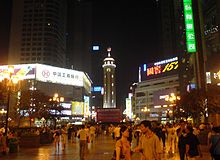 People's Liberation Monument (World War II victory monument)
People's Liberation Monument (World War II victory monument)
Chongqing was separated from Sichuan province and made into a municipality in its own right in March 1997[15] in order to accelerate its development and subsequently China's relatively poorer western areas (see China Western Development strategy).[16] An important industrial area in western China,[17] Chongqing is also rapidly urbanising. For instance, statistics[18] suggest that new construction added approximately 137,000 square meters (1.5 million square feet) daily of usable floor space to satisfy demands for residential, commercial and factory space. In addition, more than 1,300 people moved into the city daily, adding almost 100 million yuan (US$15 million) to the local economy.
Traditionally, due to its geographical remoteness, Chongqing and neighbouring Sichuan have been important military bases in weapons research and development.[19] Chongqing's industries have now diversified but unlike eastern China, its export sector is small due to its inland location. Instead, factories producing local-oriented consumer goods such as processed food, autos, chemicals, textiles, machinery and electronics are common.
Chongqing is China's third largest centre for motor vehicle production and the largest for motorcycles. In 2007, it had an annual output capacity of 1 million automobiles and 8.6 million motorcycles.[20] Leading makers of cars and motor bikes includes China's fourth biggest automaker; Changan Automotive Corp and Lifan Hongda Enterprise. The municipality is also one of the nine largest iron and steel centres in China and one of the three major aluminium producers. Important manufacturers include Chongqing Iron and Steel Company and South West Aluminium which is Asia's largest aluminum plant.[21] Agriculture remains significant. Rice and fruits (especially oranges) are the area's main produce. Natural resources are also abundant with large deposits of coal, natural gas, and more than 40 kinds of minerals such as strontium and manganese,[22] although the mining sector has been criticised for being wasteful, heavily-polluting, and unsafe.[23] Chongqing is also planned to be the site of a 10 million ton capacity refinery operated by CNPC (parent company of PetroChina) to process imported crude oil from the Sino-Burma pipelines. The pipeline itself, though not yet finished, will eventually run from Sittwe (in Myanmar's western coast) through Kunming in Yunnan province before reaching Chongqing[24] and it will provide China with fuels sourced from Myanmar, the Middle East, and Africa. Recently, there has been a drive to move up the value chain by shifting towards high technology and knowledge intensive industries resulting in new development zones such as the Chongqing New North Zone (CNNZ).[25] Chongqing's local government is hoping through the promotion of favorable economic policies for the electronics and information technology sectors, that it can create a 400 billion RMB high technology manufacturing hub which will surpass its auto industry and account for 25% of its exports.[26]
The city has also invested heavily in infrastructure to attract investment.[20][27] The network of roads and railways connecting Chongqing to the rest of China has been expanded and upgraded reducing logistical costs. Furthermore, the nearby Three Gorges Dam which is the world's largest, will not only supply Chongqing with power once completed but also allows ocean going ships to reach Chongqing's Yangtze River port.[28] These infrastructure improvements have led to the arrivals of numerous foreign direct investors (FDI) in industries ranging from auto to finance and retailing; such as Ford, Mazda, HSBC, Standard Chartered Bank, Citibank, Deutsche Bank, ANZ Bank, Scotiabank, Wal-Mart, Metro AG and Carrefour among other multinational corporations.[29]
Chongqing's nominal GDP in 2009 reached 652.8 billion yuan (US$95.5 billion) while registering an annual growth of 14.3%. However, its overall economic performance is still lagging behind eastern coastal cities such as Shanghai. For instance, its per capita GDP was 22,909 yuan (US$3,301) which is below the national average. Nevertheless, there is a massive government support to transform Chongqing into the region's economic, trade, and financial centre and use the municipality as a platform to open up the country's western interior to further development.[30]
Chongqing has been identified by the Economist Intelligence Unit in the November 2010 Access China White Paper as a member of the CHAMPS (Chongqing, Hefei, Anshan, Maanshan, Pingdingshan and Shenyang), an economic profile of the top 20 emerging cities in China.[31]
Organised crime
Main article: Chongqing gang trialsIn the first decade of the 21st century, the city became notorious for organised crime and corruption. Gangsters oversaw businesses involving billions of yuan and the corruption reached into the law-enforcement and justice systems. In 2009, city authorities under the auspices of municipal Communist Party secretary Bo Xilai undertook a massive crackdown, arresting 4,893 suspected gangsters, 'outlaws' and corrupt cadres, leading to optimism that the period of gangsterism was over.[32]
However, local media later highlighted the apparent reliance by the authorities on torture to extract confessions upon which convictions were based. In December 2009, one defence lawyer was controversially arrested and sentenced to 18 months in prison for "coaching his client to make false claims of torture" and in July 2010, another lawyer released videotapes of his client describing the torture in detail.[33][34]
Economic and technological development zones
The city includes a number of economic and technological development zones:
- Chongqing Chemical Industrial Park
- Chongqing Economic & Technological Development Zone
- Chongqing Hi-Tech Industry Development Zone
- Chongqing New North Zone (CNNZ)
- Chongqing Export Processing Zone
- Jianqiao Industrial Park (located in Dadukou District)
Transport
Since its elevation to national-level municipality in 1997, the city has dramatically expanded its transportation infrastructure. With the construction of railways and expressways to the east and southeast, Chongqing is a major transportation hub in southwestern China. The municipality now has 25 bridges across the Yangtze River including half a dozen in the city's urban core.
River port
 Hydrofoil on the Yangtze, within the Chongqing municipality
Hydrofoil on the Yangtze, within the Chongqing municipality
Chongqing is the biggest inland river port in western China. Historically, most of its transportation, especially to eastern China, is via the Yangtze River. In recent years the amount of trading has increased because of the huge reserviour created behind The Three Gorges Dam.
Railways
Chongqing is a major rail hub in south central China.
- Chongqing-Chengdu (Sichuan province) railway
- Chengdu-Chongqing High-speed Railway (under construction)
- Chongqing-Guiyang (Guizhou province) railway
- Chongqing-Xiangfan (Hubei province) railway
- Chongqing-Huaihua (Hunan province) railway
- Chongqing-Suining (Sichuan province) express railway
- Chongqing-Lichuan Railway (Yuli Railway), providing access to the Yichang-Wanzhou Railway in Hubei (under construction)
- Chongqing-Lanzhou (Gansu province) railway (under construction)
Highways
- Chongqing-Chengdu Expressway
- Chongqing-Chengdu 2nd Expressway (under construction)
- Chongqing-Wanzhou-Yichang highway (Wanzhou-Yichang section under construction)
- Chongqing-Guiyang highway
- Chongqing-Changsha Expressway (Xiushan-Changsha section under construction)
- Chongqing-Dazhou-Xi'a highway (Dazhou-Xi'an section under construction)
- Chongqing-Suining Express way
- Chongqing-Nanchong Express way
- China National Highway 210
- China National Highway 212
Airport
Chongqing Jiangbei International Airport, located in Yubei district, north of Chongqing city, provides links to all parts of China, many South East Asian countries and soon the Middle East (November 2011) and Europe (March 2012). In year 2010, the airport reported close to 16 million people in passenger volume, which ranked it as the 10th in importance in China. Currently, it's the only airport in central and western China which has railway (lite-rail) city transportation access under construction, (CRT Line 3) and two runways in normal use.
Public transport
Main article: Chongqing MetroThe three main forms of public transport in Chongqing are CRT metro, intercity railway, and the ubiquitous bus system.
According to the Chongqing Municipal Government's ambitious plan in May 2007, Chongqing is going to invest 150 billion RMB over 13 years to finish a system that combines underground metro lines with light rail (heavy monorail). By 2020 this network will consist of 6 straight lines and 1 circular line; Line 1 and Line 6 will be underground metro while Lines 2 and 3 will be High Capacity light rail. These improvements will add 363.5 kilometers of road and railway to the existing transportation infrastructure and 93 new train stations will be added to the 111 stations that are already in place.
As of 2011[update] two metro lines, the 14 km long CRT Line 1, a conventional subway, and the 19 km long heavy monorail CRT Line 2 (through Phase II), had been opened. Total track mileage is 35.55 km. Line 3, a new heavy monorail currently in trials is expected to open later in 2011. A new subway, Line 6, is under construction and is expected to open in 2012.
By 2050 Chongqing was planned to have ten railway lines, totaling 513 kilometres, with 270 stations.,[35] although more recent reports have now indicated as many as 18 lines are planned or proposed.
Culture
Language
Main article: Sichuanese MandarinThe language native to Chongqing is Southwestern Mandarin. More precisely, the great majority of the municipality, save for Xiushan, speak Sichuanese, including the primary Chengdu-Chongqing dialect and Minjiang dialect spoken in Jiangjin and Qijiang.[36] There are also a few speakers of Xiang and Hakka in the municipality, due to the great immigration wave to the Sichuan region (湖广填四川) during the Ming and Qing Dynasties. In addition, in parts of southeastern Chongqing, the Miao and Tujia languages are also used by some Miao and Tujia people.[37]
Tourism
As the provisional Capital of China for almost ten years (1937 to 1945), the city was also known as one of the three headquarters of the Allies. Chongqing has many historical World War II buildings or sites (some of which have since been destroyed):
- The People's Liberation Monument, located in the center of Chongqing city used to be the highest building in the area but is now surrounded and dwarfed by numerous shopping centres. Originally named the Monument for the Victory over Axis Armies, it is the only building in China for that purpose. Today, the monument serves as a symbol for the city.
- Chongqing Museum
- General Joseph W. Stilwell Museum dedicated to General "Vinegar Joe" Stilwell.
- Great Hall of the People (Chongqing), based on the Great Hall of the People in Beijing. This is one of the largest public assembly buildings in China which, though built in modern times, emulates traditional architectural styles. It is adjacent to the densely populated and hilly central district, with narrow streets and pedestrian only walkways.
- Renmin Hotel
- Luohan Si, Ming Dynasty temple
- The air force cemetery in the Nanshan area, in memory of those air force personnel killed during the Second Sino-Japanese War (1937–1945);
- The former sites for embassies of major countries during the 1940s. As the capital at that time, Chongqing had many residential and other buildings for these officials.
- Red Rock Village Museum, a diplomatic site for the Communist Party in Chongqing led by Zhou Enlai during World War II. It is where Mao Zedong signed the "Double 10 (10 October) Peace Agreement" with the Kuomintang.
Besides these historical sites, Chongqing also has the following attractions:
- Wuxi County is noted as a majour tourism area of Chongqing.
- The Dazu Rock Carvings, in Dazu county, are a series of Chinese religious sculptures and carvings, dating back as far as the 7th century A.D., depicting and influenced by Buddhist, Confucian and Taoist beliefs. Listed as a UNESCO World Heritage Site, the Dazu Rock Carvings are made up of 75 protected sites containing some 50,000 statues, with over 100,000 Chinese characters forming inscriptions and epigraphs.
- The Three Natural Bridges and Furong Cave in Wulong Karst National Geology Park, Wulong County are listed as a UNESCO World Heritage Site as part of the South China Karst).
- Ciqikou is a 1000-year-old town in the Shapingba District of Chongqing. It is also known as Little Chongqing. The town, located next to the lower reaches of the Jialing River, was at one time an important source of chinawares and used to be a busy commercial dock during the Ming and Qing Dynasties.
- Fishing Town or Fishing City, also called the “Oriental Mecca” and “the Place That Broke God's Whip”, is one of the three great ancient battlefields of China. It is noted for its resistance to the Mongol armies during the Southern Song Dynasty (1127–1279) and the location where the Mongol leader Möngke Khan died in 1259.
- Xueyu Cave in Fengdu County is the only example[citation needed] of a pure-white, jade-like karst cave in China.
- A modern and well stocked zoo exhibits many national and regional animals, including the Giant Panda and the extremely rare South China Tiger.
Media
Chongqing is served by the Chongqing People's Broadcast Station as the largest radio station. The only municipal-level TV network is Chongqing TV station, claimed to be the 4th largest television station.[citation needed] Chongqing Daily is the largest newspaper group, controlling more than 10 newspapers and one website.
Cuisine
One distinct trait of Chongqing cuisine is that it is spicy and numbing (麻辣), as opposed to the spicy and fragrant (香辣) flavours of Chengdu cuisine.
- Hot pot is Chongqing's local culinary specialty. Tables in hotpot restaurants usually have a central vat (or pot) where food ordered by the customers is boiled in a spicy broth. As well as beef, pork, lotus and other vegetables, items such as pig's kidney, brain, duck's bowels, and cow's stomach are often consumed.
Sports
Professional sports teams in Chongqing include:
- Chinese Football Association Super League
Religion
Arhat Temple is a Buddhist temple, which includes monks. The Dazu Rock Carvings are religious sculptures, which present a World Heritage Site. A large Buddha sculpture is outside Shuangjiang. Laitan has a Buddha Temple. Though the Christian population is small, a Roman Catholic Archdiocese of Chongqing exists. Persecution of Christians takes place in Chongqing.[38]
Education
Colleges and universities
See also: List of universities and colleges in ChongqingMiddle and high schools
- Chongqing Nankai Middle School (重庆南开中学) founded in 1935
- Bashu Middle School (巴蜀中学) founded in 1933
- Chongqing No. 1 Middle School (重庆第一中学)
- Chongqing No. 8 Middle School (重庆第八中学)
- Chongqing Foreign Languages School (重庆外国语学校) founded in 1963
International schools
- Yew Chung International School of Chongqing (重庆耀中国际学校) website in English
- QSI International School of Chongqing (重庆科爱赛国际学校) website in English
International relations
Consulates
Consulate Date Consular District  Canada Consulate Chongqing[39]
Canada Consulate Chongqing[39]05.1998 Chongqing, Sichuan, Guizhou, Yunnan  United Kingdom Consulate General Chongqing[39]
United Kingdom Consulate General Chongqing[39]03.2000 Chongqing, Sichuan, Guizhou, Yunnan  Cambodia Consulate General Chongqing[39]
Cambodia Consulate General Chongqing[39]12.2004 Chongqing, Hubei, Hunan, Shaanxi  Japan Consulate General Chongqing[39]
Japan Consulate General Chongqing[39]01.2005 Chongqing, Sichuan, Guizhou, Yunnan  Denmark Consulate Chongqing[39]
Denmark Consulate Chongqing[39]07.2005 Chongqing, Sichuan, Guizhou, Yunnan  Philippines Consulate General Chongqing[39]
Philippines Consulate General Chongqing[39]12.2008 Chongqing, Guizhou, Yunnan  Hungary Consulate General Chongqing[39]
Hungary Consulate General Chongqing[39]02.2010 Chongqing, Sichuan, Guizhou, Yunnan, Shaanxi, Gansu  Ethiopia Consulate General Chongqing[39]
Ethiopia Consulate General Chongqing[39]11.2011 Chongqing, Sichuan, Guizhou, Yunnan Twin towns — sister cities
See also: List of twin towns and sister cities in ChinaChongqing is twinned with:
Africa
 Addis Ababa, Ethiopia
Addis Ababa, Ethiopia
Asia
 Hiroshima, Japan
Hiroshima, Japan Mito, Ibaraki, Japan
Mito, Ibaraki, Japan Bangkok, Thailand
Bangkok, Thailand Banjarmasin, Indonesia
Banjarmasin, Indonesia Shiraz, Iran
Shiraz, Iran
Europe
 Toulouse, France
Toulouse, France Leicester, England, United Kingdom
Leicester, England, United Kingdom Wales, United Kingdom[40]
Wales, United Kingdom[40] Düsseldorf, Germany[41]
Düsseldorf, Germany[41] Trikala, Greece
Trikala, Greece Vladimir, Russia
Vladimir, Russia Voronezh, Russia
Voronezh, Russia Sør-Trøndelag, Norway
Sør-Trøndelag, Norway Zaporizhia, Ukraine
Zaporizhia, Ukraine
North America
 Seattle, United States
Seattle, United States Vacaville, California, United States
Vacaville, California, United States Detroit, United States
Detroit, United States Toronto, Canada
Toronto, Canada Waterloo, Ontario, Canada
Waterloo, Ontario, Canada
Oceania
 Brisbane, Australia
Brisbane, Australia
South America
In June 2007, a twinning agreement between Chongqing and Sør-Trøndelag was signed.[42]
See also
Notes
- ^ a b "重庆市2010年第六次全国人口普查主要数据公报". Netease. 2011-05-03. http://news.163.com/11/0503/01/733HTAIV00014AED.html.
- ^ List of Chinese administrative divisions by area
- ^ http://www.cq.xinhuanet.com/subject/2005/2005-08/12/content_4869354.htm
- ^ http://www.cq.xinhuanet.com/subject/2005/2005-08/12/content_4868903.htm
- ^ http://2011.cqlib.cn/article_detail.asp?cid=13&rid=1&did=622
- ^ a b c d "中国地面国际交换站气候标准值数据集 (1961-1990年)" (in Simplified Chinese). China Meteorological Administration. May 2011. http://cdc.cma.gov.cn/shuju/search1.jsp?dsid=SURF_CLI_CHN_MUL_MMON_19611990_CES&tpcat=SURF&type=table&pageid=3. Retrieved 2011-05-23.
- ^ "Extreme Temperatures Around the World". http://www.mherrera.org/temp.htm. Retrieved 2010-08-28.
- ^ 重庆调整部分行政区划:4区(县)并为2区
- ^ "Chongqing Municipality". IES Global. http://iesglobal.com/index.php?option=com_content&task=view&id=450&Itemid=404. Retrieved 2011-07-17.
- ^ "Chongqing -- City of Hills, Fog and Spicy Food". China.com. http://english.china.com/zh_cn/tourism/chongqing/11047307/20060331/13212034.html. Retrieved 2011-07-17.
- ^ "China's Chongqing starts household registration reform". Xinhua News. 2010-07-02. http://news.xinhuanet.com/english2010/china/2010-07/29/c_13420830.htm. Retrieved 2010-08-12.
- ^ a b "Residence Status of Population by Region and Sex (2004)". National Bureau of Statistics of China, in allcountries.org. 2005. http://www.allcountries.org/china_statistics/4_8_residence_status_of_population_by.html. Retrieved 2010-08-12.
- ^ "Age Composition and Dependency Ratio of Population by Region (2004)". National Bureau of Statistics of China, in allcountries.org. 2005. http://www.allcountries.org/china_statistics/4_9_age_composition_and_dependency_ratio.html. Retrieved 2010-08-12.
- ^ "Number and Size of Family Households by Region (2004)". National Bureau of Statistics of China, in allcountries.org. 2005. http://www.allcountries.org/china_statistics/4_13_number_and_size_of_family.html. Retrieved 2010-08-12.
- ^ Chinese vice premier urges Chongqing to become economic engine for western regions - Embassy of the People's Republic of China in Australia - retrieved 2009-01-31.
- ^ China urges reform, development of Chongqing municipality - Xinhua News Agency - retrieved 2009-01-31.
- ^ "Market Profiles on Chinese Cities and Provinces (hktdc.com)". Tdctrade.com. http://www.tdctrade.com/mktprof/china/mpchq.htm. Retrieved 2011-03-14.
- ^ "Wikinomics: How Mass Collaboration Changes Everything," Don Tapscott and Anthony D. Williams, Penguin, p. 218, 2006.
- ^ Chongqing Municipality(重慶市) - The Australia-China Chamber of Commerce and Industry of New South Wales - retrieved 2009-01-31.
- ^ a b Critical Eye on Chongqing - Pillar of the West - China Business Review - retrieved 2009-01-31.
- ^ "China's west seeks to impress investors". BBC News. 2005-05-04. http://news.bbc.co.uk/2/hi/business/4512015.stm. Retrieved 2010-04-28.
- ^ Coal reserves ≈ 4.8 billion tonnes. Chuandong Natural Gas Field is China's largest inland gas field with deposits of around 270 billion m³ - more than 1/5 of China's total. Has China's largest reserve of strontium (China has the world's 2nd biggest strontium deposit). Manganese is mined in the Xiushan area.
- ^ A survey in 2005 by China’s State Environmental Protection Administration (SEPA) found 13 firms in the manganese triangle had breached targets on the release of hexavalent chromium and ammonia-nitrogen – in the worst case, by a factor of 180. The cleanup ordered by SEPA resulted in firms closing and the expenditure of 280 million yuan.
- ^ "Asia Times Online: China Business News : China-Myanmar pipeline projects on track". Atimes.com. 2007-04-24. http://www.atimes.com/atimes/China_Business/ID24Cb01.html. Retrieved 2011-03-14.
- ^ welcome to www.cnnz.gov.cn
- ^ "China Business News : HP Foxcom Setup Laptop Plants in Chongqing". The China Perspective. http://thechinaperspective.com/index.php?cmd=pharticle&articleid=6216. Retrieved 2011-03-14.
- ^ "Chongqing Investment Zone Profiles". Allroadsleadtochina.com. 2007-05-30. http://www.allroadsleadtochina.com/index.php/2007/05/30/fdi-and-investment-zones-part-iii-chongqing/. Retrieved 2011-03-14.
- ^ China's Three Gorges Dam - CNN - retrieved 2009-01-31.
- ^ "Ford weighs third China plant to meet demand". Reuters. 2008-04-18. http://www.reuters.com/article/businessNews/idUSN1845570620080418?feedType=RSS&feedName=businessNews.
- ^ Innovative City in West China Chongqing (PDF) - Jon Sigurdson and Krystyna Palonka of Stockholm School of Economics, EIJS - retrieved on 1 February 2009.
- ^ "The Rise Of The ‘Champs’ - New Report Maps Business Opportunity In China’s Fastest Growing Cities". Sourcewire.com. 2010-11-09. http://www.sourcewire.com/releases/rel_display.php?relid=60590. Retrieved 2011-03-14.
- ^ Chongqing on the mend after crackdown on criminal gangs, SCMP, 5 Oct 2009
- ^ Lawyer reveals grim details of client's torture, Ng Tze-wei, SCMP, 29 Jul 2010
- ^ Ramzy, Austin (2010-03-15). "China's Dark City: Behind Chongqing's Crime Crackdown". Time (Chongqing). http://www.time.com/time/magazine/article/0,9171,1969642,00.html. Retrieved 2010-08-09.
- ^ Chongqing Daily (23 March 2008)
- ^ 翟时雨 (Ruo Shiyu) (2003). "中篇第四节:四川话的分区 (The divisions of the Sichuan dialect)" (in Simplified Chinese). 《汉语方言学》 (The Study of Chinese Languages). 西南师范大学出版社 (Southwest China Normal University Press). ISBN 7-5621-2942-8/H•49.
- ^ "苗族:特色苗语 (The Miao People: Characteristics of the Miao language)". http://www.aluzhou.com/custom/detail.asp?ID=127. Retrieved 2010-07-31.
- ^ http://www.state.gov/g/drl/rls/irf/2006/71338.htm
- ^ a b c d e f g h "各国驻华领馆领区一览表 (in Simplified Chinese)". 中华人民共和国外交部. 2007-05-08. http://www.fmprc.gov.cn/chn/gxh/tyb/bszn/lsfw/t246715.htm.
- ^ "Why Chongqing? Wales Week The Trade Mission Chongqing, 1–8 March" (PDF). http://www.ibwales.com/upload/pdf/Chongqing_Trade_Mission_Flyer.pdf. Retrieved 2011-03-14.
- ^ "Twin Towns". Amazingdusseldorf.com. http://www.amazingdusseldorf.com/community-local/people/twin-towns.html. Retrieved 2009-10-29.
- ^ "Chongqing Municipality and Sør-Trøndelag county signs Twinning-Agreement (Norway - the official site in China)". Norway.cn. 2007-06-14. http://www.norway.cn/norway_and_china/friendship/TwinningAgreement.htm. Retrieved 2011-03-14.
References
- Danielson, Eric N. (2005). "Chongqing," pp.325-362 in The Three Gorges and the Upper Yangzi. Singapore: Marshall Cavendish/Times Editions. ISBN 981-232-599-9.
- Danielson, Eric N. (2005). "Revisiting Chongqing: China's Second World War Temporary National Capital," in Journal of the Royal Asiatic Society, Hong Kong Branch, Vol.45. Hong Kong: Royal Asiatic Society, Hong Kong Branch.
- Huang, Jiren (1999). Lao Chongqing (Old Chongqing): Ba Shan Ye Yu (part of the "Lao Cheng Shi" series. Nanjing: Jiangsu Meishu Chubanshe (Jiangsu Fine Arts Publishing House).
- Kapp, Robert A. (1974). "Chungking as a Center of Warlord Power, 1926-1937," pp.143-170 in The Chinese City Between Two Worlds, ed. by Mark Elvin and G. William Skinner. Stanford: Stanford University Press.
- Kapp, Robert A. (1973). Szechwan and the Chinese Republic: Provincial Militarism and Central Power, 1911-1938. New Haven: Yale University Press.
- Liao, Qingyu (2005). Chongqing Ge Le Shan Pei Du Yizhi (The Construction of War-time Capital on the Gele Mountain, Chongqing). Chengdu: Sichuan Da Xue Chubanshe (Sichuan University Press).
- Long, Juncai (2005). Sui Yue Ya Feng de Jiyi: Chongqing Kang Zhan Yizhi (Covered Memory of Flowing Years: Site[s] of [the] Anti-Japanese War in Chongqing). Chongqing: Xi Nan Shi Fang Da Xue Chubanshe (Southwest University Press).
- McIsaac, Lee (2000). "The City as Nation: Creating a Wartime Capital in Chongqing," in Remaking the Chinese City, 1900-1950, ed. by Joseph W. Esherick. Honolulu: University of Hawaii Press.
- Xu, Dongsheng and Liu, Yuchuan, et al. (1998). Chongqing Jiu Ying (Old Photos of Chongqing). Beijing: Renmin Meishu Chubanshe People’s Fine Arts Publishing House).
External links
- Chongqing Municipal Government website
- Video: A Bird's Eye View of the New Chongqing (2008)
- Video: A Bird's Eye View of the New Chongqing (2005)
- CCTV9 Apr. 2009 program - Chongqing: Visions of Change
- Chongqing travel guide from Wikitravel
- Economic profile for Chongqing at HKTDC

Shaanxi 
Sichuan 
Hubei  Chongqing
Chongqing 

Guizhou Hunan Categories:- Chongqing
- Independent cities
- Metropolitan areas of China
- Municipalities of the People's Republic of China
- Port cities and towns in China
- Populated places established in the 5th century BC
- Populated places on the Yangtze River
- Western China
Wikimedia Foundation. 2010.

